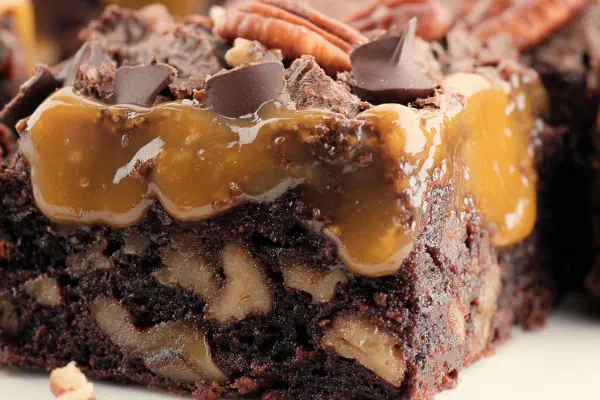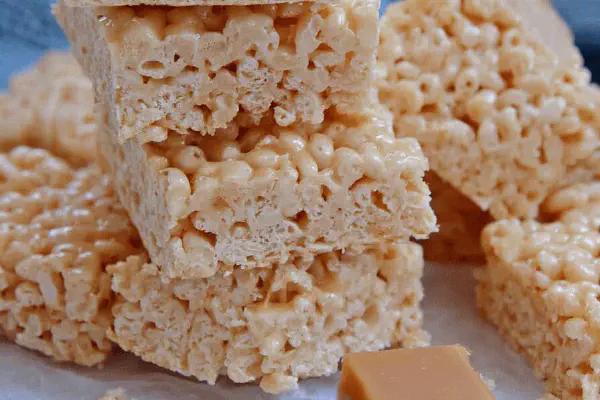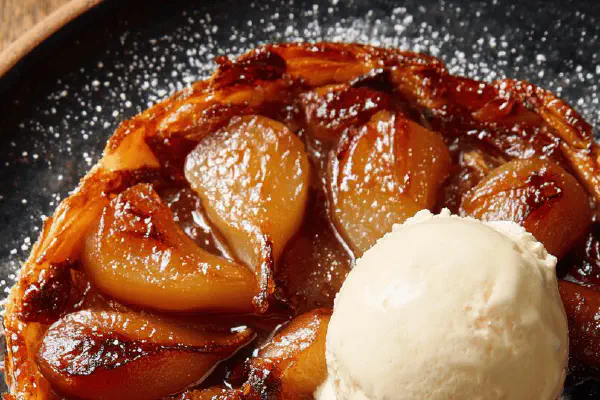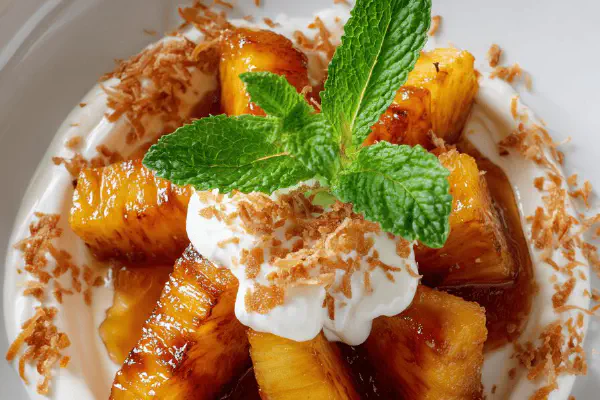Featured Recipe
Baked Caramelized Apples Twist
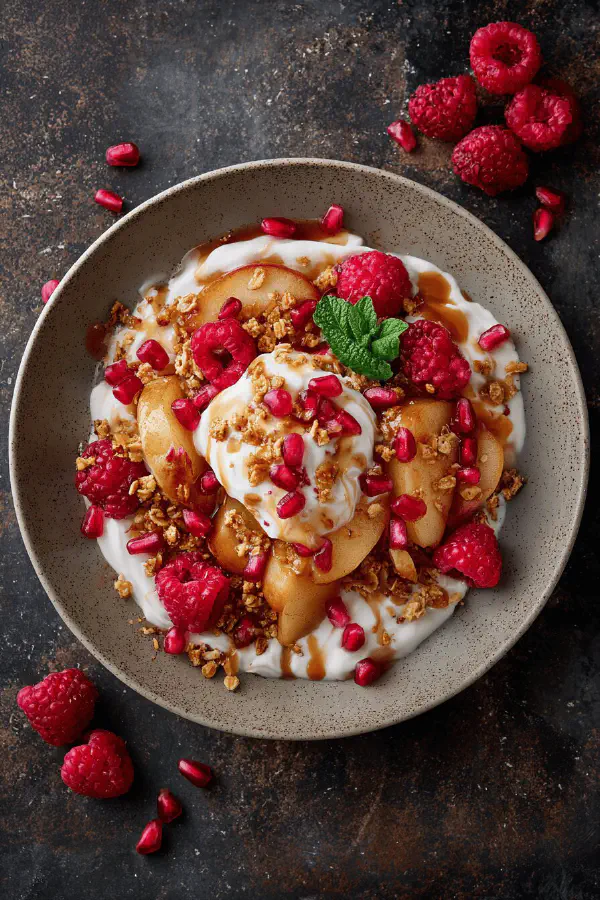
By Kate
"
Apples halved and baked under amber caramel, chill then serve with creamy Greek-style coconut yogurt, fresh raspberries, pomegranate seeds, and toasted coconut granola. Sugar caramelizes with water to amber stage, coating fruit that softens but holds shape. Chilling firms texture; yogurt adds cooling tang. Fresh fruit bursts counterbalance sweet, nutty granola brings texture. Swap brown sugar for white or try maple syrup caramel. Pear or quince can replace apples for seasonal shift. Timing based on color, softness, aroma. Covered baking traps steam, keeps fruit tender. Cooling critical—too warm yogurt melts, too cold dulls flavors. Visual and tactile cues guide doneness—caramel dark and thick, apples fork tender but intact.
"
Prep:
15 min
Cook:
50 min
Total:
Serves:
6 servings
dessert
apples
caramel
yogurt
Introduction
Staring at those perfect Pink Lady apples sitting ready. Halfway through caramelizing sugar, aroma bursts out—roasted sugar hits nose just so. Watch the bubbling caramel shift color—too pale and it’s sweet but watery, too dark and bitter creeps. The foil traps steam while baking; that’s the secret to tender flesh that resists mushiness. Cooling fully before flipping keeps caramel intact on flesh. Chilling sets texture, makes it easier to plate dramatically. Raspberries add acid pop; pomegranate gives jewel-like bursts. Toasted coconut granola—nutty crunch amid tender fruit and creamy yogurt layers. Sugar can crystalize if rushed; patience helps. That yogurt variant? Go with coconut-infused for a tropical twist; richness against tang. Alternative fruits swap but timing tweaks required. Keep an eye on texture not the clock, always. You want yielding but not mushy fruit, glossy amber caramel coating, chilled but not cold yogurt. Sound comes alive—caramel bubbling, apples softly giving, crunchy granola under fork. Expect a bit sticky, sweet, tangy, crunchy rhythm. Simple, layered, nuanced.
Ingredients
About the ingredients
Scaling quantities down by about 30% trims excess carbs and sugar—less risk of over-sweetening. Using Pink Lady apples over Royal Gala—they hold shape better with tang, acidic edge balances sugar. Light brown sugar chosen for richer caramel notes than plain white. Water quantity increased slightly to give more gentle caramel, avoid burning quickly. Coconut Greek-style yogurt swapped in for dairy Greek—adds tropical aroma, dairy-free option. Granola has toasted coconut and almonds instead of plain—adds texture, nutty depth, no walnuts or gluten. Raspberries and pomegranate seeds stay fresh for acidity contrast but can be swapped with blackberries or chopped fresh figs for seasonal variations. Critical to choose yogurt with thick texture not runny; thinning dilutes effect on plate. Use parchment-lined dish if possible to ease cleanup—caramel can stick stubbornly to metal pans and nothing ruins plating mood faster than scraping burnt sugar.
Method
Technique Tips
Step order rearranged to emphasize caramel first, then baking. Watching caramel develop amber hue is a critical skill—too soon, sugar won’t crystallize correctly; too late, bitterness dominates. Covering apples traps steam preventing desiccation—common error is uncovered baking leading to tough skins. Flip apples after baking to coat flesh with caramel—adds visual interest and flavor on plating—don’t skip chilling after this step, often overlooked, crucial to firm whole assembly before yogurt topping. Chilling time adjusted down slightly; texture changes notably even at 90 minutes not just 2 hours, saves time without losing quality. At serving, dab rather than drown yogurt over apples—too much moisture breaks caramel coating down. Use back of spoon to gently press fruit and test doneness mid-bake. Granola toasted separately to boost crunch and prevent sogginess from residual moisture on fruit. Handle caramel with care—cooling traps residual heat, can cause burns if misjudged. Reheating caramel depends on texture—granular means too long cooked, add splash water to smooth. Substitutions noted to suit allergies, seasonal ingredient availability, or dietary preferences to keep dessert accessible yet refined.
Chef's Notes
- 💡 Choosing apples matters—Pink Lady, not Granny Smith. They hold shape. Mix textures. Swap toppings: yogurt and granola; prefer thick yogurt.
- 💡 Watch caramel—color change means texture change. Too clear won’t work. Wait for amber; bubbles shift, aroma builds, avoid burning.
- 💡 Cooling is critical. Let apples sit post-bake until warm. Chilling firms up yogurt—don’t skimp on this. Too warm and it melts.
- 💡 Consider fruit swaps. Pears can work, but time changes. Quince is classic. Pomegranate seeds add tang. Raspberries burst with fresh.
- 💡 Caramel crystals? Reheat gently—stir. If grainy, barely warm, splash of water. Avoid high heat; stirring prevents burning—needed for smooth.
Kitchen Wisdom
Can I make it ahead?
Yes. Up to a day before. Chill fully. But don’t layer yogurt too soon. Risk a soggy mess.
What if caramel doesn’t work?
Start over or try reducing heat. Watch closely. Sometimes add a splash of water if too thick.
How to store leftovers?
Cover tightly. Keep cold. Yogurt can absorb odors. Reheat apples gently. Avoid overheating to keep texture.
Can I use different fruits?
Yes. Try seasonal options—blackberries, figs. Adjust baking time accordingly, softer fruits cook quicker.
